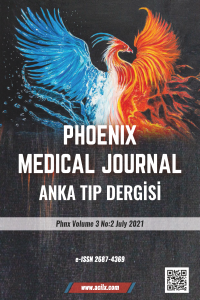Öz
An 84-year-old female patient applied to the emergency service with neck pain. The patient fell lost in the bathroom. In the anamnesis of the patient, it is seen that she had diabetes mellistus, hypertension and no other history of disease. On her physical examination, the vital signs of were with in normal limits and there was tenderness on both scapula and midline tenderness on cervical vertebra. Computed tomography showed that fragmented fracture on cervical second vertebral corpus. The patient was discharged with a collar and analgesics.
Axis fractures are classified into three groups. These are; odontoid fractures, hangman fractures (traumatic spondylolysis) and nonodontoid nonhangman fractures (1). Odontoid and hangman fractures are relatively common fractures of the axis (1). Our case was nonodontoid nonhangman fracture which is the rarest type of axis fractures. In our case, conservative treatment was preferred because of it was Benzel type 1 fracture and had no accompanying soft tissue injury (2).
Anahtar Kelimeler
Kaynakça
- 1. Benzel EC, Hart BL, Ball PA, et al: Fractures of the C-2 vertebral body. J Neurosurg. 1994;81:206–12.
- 2. Ryken TC, Hadley MN, Aarabi B, Dhall SS, Gelb DE, Hurlbert RJ, et al: Management of isolated fractures of the axis in adults. J Neurosurg. 2013;72 (2):132–50.
Öz
An 84-year-old female patient applied to the emergency service with neck pain. The patient fell lost in the bathroom. In the anamnesis of the patient, it is seen that she had diabetes mellistus, hypertension and no other history of disease. On her physical examination, the vital signs of were with in normal limits and there was tenderness on both scapula and midline tenderness on cervical vertebra. Computed tomography showed that fragmented fracture on cervical second vertebral corpus. The patient was discharged with a collar and analgesics.
Axis fractures are classified into three groups. These are; odontoid fractures, hangman fractures (traumatic spondylolysis) and nonodontoid nonhangman fractures (1). Odontoid and hangman fractures are relatively common fractures of the axis (1). Our case was nonodontoid nonhangman fracture which is the rarest type of axis fractures. In our case, conservative treatment was preferred because of it was Benzel type 1 fracture and had no accompanying soft tissue injury (2).
Anahtar Kelimeler
Kaynakça
- 1. Benzel EC, Hart BL, Ball PA, et al: Fractures of the C-2 vertebral body. J Neurosurg. 1994;81:206–12.
- 2. Ryken TC, Hadley MN, Aarabi B, Dhall SS, Gelb DE, Hurlbert RJ, et al: Management of isolated fractures of the axis in adults. J Neurosurg. 2013;72 (2):132–50.
Ayrıntılar
| Birincil Dil | İngilizce |
|---|---|
| Konular | Acil Tıp |
| Bölüm | Görüntü Sunumu |
| Yazarlar | |
| Yayımlanma Tarihi | 1 Temmuz 2021 |
| Gönderilme Tarihi | 22 Şubat 2021 |
| Kabul Tarihi | 10 Mart 2021 |
| Yayımlandığı Sayı | Yıl 2021 Cilt: 3 Sayı: 2 |

Anka Tıp Dergisi Creative Commons Atıf 4.0 Uluslararası Lisansı ile lisanslanmıştır.
Anka Tıp Dergisi Budapeşte Açık Erişim Deklarasyonu’nu imzalamıştır.



